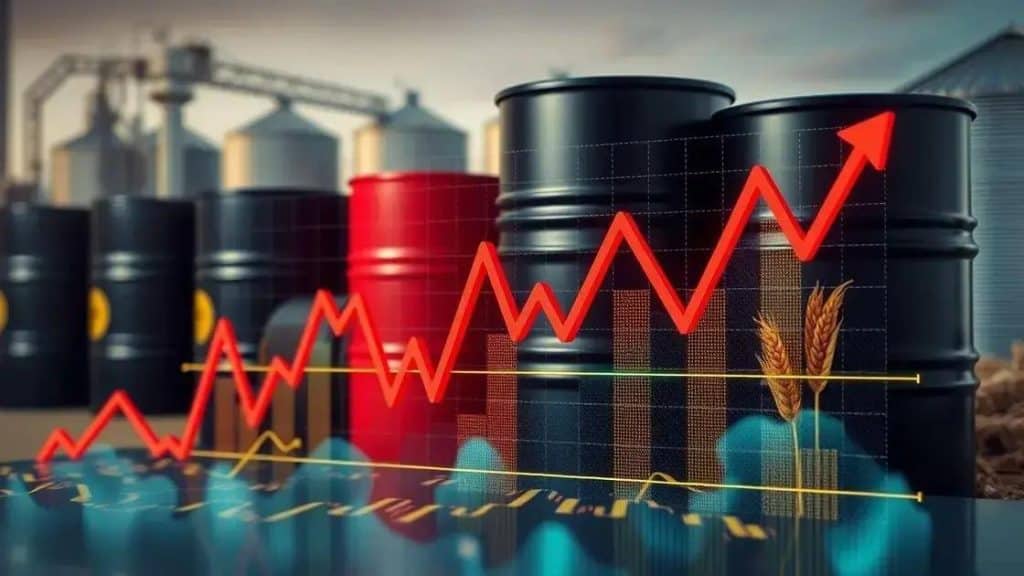Commodity price fluctuation analysis: what you need to know

Commodity price fluctuations significantly impact inflation, business costs, and global trade dynamics, influencing both consumer behavior and investment strategies in various sectors.
Commodity price fluctuation analysis is essential for anyone involved in trading or investing. Have you noticed how unpredictable these prices can be? Let’s delve into the reasoning behind these changes and their implications.
Understanding commodity price fluctuations
Understanding commodity price fluctuations is vital for investors and businesses alike. The prices of commodities can vary widely due to numerous factors, and grasping these elements can help one make informed decisions.
Factors Affecting Commodity Prices
Many factors can cause price fluctuations in commodities. Awareness of these elements is key to anticipating market movements.
- Supply and demand dynamics
- Geopolitical events
- Changes in currency values
- Weather conditions affecting agriculture
Each factor plays a unique role in how prices change over time. For instance, when demand for oil increases, prices often rise if supply cannot keep pace. Conversely, oversupply can lead to falling prices, impacting various industries.
Market Trends and Historical Data
Studying historical data provides insights into past fluctuations. Analyzing trends reveals patterns that can help predict future price changes. By examining charts and graphs, investors can identify potential opportunities.
One should also pay attention to how economic indicators correlate with commodity prices. These might include employment rates, inflation, and overall economic growth. Understanding these relationships helps in making sound financial choices.
Moreover, technological advances in farming and extraction methods can also influence commodity prices. Innovations may lead to lower production costs, impacting how commodities are priced in markets.
Conclusion
Grasping the complexities of commodity price fluctuations allows stakeholders to navigate the market effectively. If you keep an eye on relevant factors and trends, you can position yourself to take advantage of market movements.
Factors influencing commodity prices

Several key factors influence commodity prices globally. Understanding these elements can help investors and consumers make better decisions.
Supply and Demand
At the heart of commodity price fluctuations lies the concept of supply and demand. When demand increases but supply remains constant, prices go up. Conversely, if there is a surplus in supply, prices may drop considerably. This relationship is foundational in the commodities market.
- A drought affecting crop yields can drive up food prices.
- Unexpected natural disasters can disrupt supply chains.
- Increased industrial production may raise demand for metals.
In addition to these immediate impacts, long-term trends in supply and demand can also shift. For example, growing economies like India and China significantly affect global demand for oil.
Geopolitical and Economic Factors
Political events in commodity-producing countries can create unrest and lead to price volatility. For instance, conflicts in oil-rich regions often result in price spikes. Additionally, changes in government policies can lead to production limits or export tariffs, which may further influence prices. Global economic conditions, such as a recession, can lead to decreased demand, affecting prices negatively.
Currency values also play a significant role in determining commodity prices. For example, when the U.S. dollar weakens, commodities priced in dollars become cheaper for foreign buyers, potentially boosting demand and driving up prices.
Technological Advances
Innovations in production and extraction techniques can bring down costs, thereby affecting prices. For example, advancements in fracking have changed the landscape of oil prices dramatically. These technologies not only influence costs but can also increase supply, leading to unexpected price shifts in the market.
Staying informed about these various factors is essential for anyone involved in commodities, as they can have profound effects on market dynamics. By monitoring trends and understanding how these influences interact, investors can better prepare for shifts in commodity pricing.
Strategies for analyzing commodity trends
Analyzing commodity trends is crucial for investors and traders. Implementing various strategies can help one stay ahead of the market.
Technical Analysis
One common approach is technical analysis. This involves studying past market data, particularly price and volume, to identify trends. By using various charting techniques, investors can spot patterns and make predictions about future movements.
- Look for support and resistance levels.
- Use moving averages to identify current trends.
- Consider momentum indicators to assess the strength of a trend.
Technical analysis enables traders to make informed decisions based on data rather than emotions.
Fundamental Analysis
Another approach to understanding commodity trends is fundamental analysis. This includes examining factors such as supply and demand, production levels, and external influences like geopolitical events or economic policies. Evaluating these elements provides insights into why prices may move in certain directions.
By analyzing reports on inventory levels or crop yields, investors can better predict how these changes may impact prices. Monitoring global events is also essential, as they often have swift effects on markets.
Staying Updated with News and Reports
Staying updated with news sources and industry reports is crucial for any investor. Organizations like the U.S. Department of Agriculture (USDA) or the International Energy Agency (IEA) regularly publish statistics and forecasts that can provide valuable insights. By staying informed, investors can adjust their strategies based on the latest trends.
Networking with other professionals and joining online forums can also be beneficial. Engaging with others in the industry enables individuals to share insights and strategies, further enhancing their understanding of the market.
Impact of price fluctuations on the economy

The impact of price fluctuations on the economy is significant and multifaceted. When commodity prices change, they can influence various sectors, from agriculture to technology.
Effects on Inflation
One major consequence of rising commodity prices is inflation. As the cost of raw materials increases, companies often pass these costs to consumers. This can lead to a rise in overall prices for goods and services, affecting the purchasing power of consumers.
- Higher fuel prices can increase transport costs.
- Increased food prices can reduce disposable income.
- Manufacturers may be forced to raise prices to maintain profit margins.
These inflationary pressures can squeeze household budgets and lead consumers to spend less, slowing economic growth.
Impact on Businesses
Businesses are also affected when commodity prices fluctuate. For industries heavily reliant on raw materials, such as construction and manufacturing, sudden price increases can dramatically alter profit margins. When budgets are strained, companies might have to reconsider their investment plans.
Smaller businesses often feel these changes more acutely than larger corporations. They may struggle to absorb increased costs, leading to layoffs or even closures in extreme cases.
Global Trade Dynamics
The fluctuations can have broader effects on global trade. Countries dependent on exporting commodities may experience growth when prices rise, boosting their economies. Conversely, nations reliant on imports suffer when prices increase, which can lead to trade imbalances.
Moreover, fluctuations can affect currency values as well. A weakened currency may make imported commodities more expensive, further affecting local economies.
Conclusion: Understanding the impact of commodity price fluctuations on the economy is crucial. These price changes affect inflation, influence businesses, and reshape global trade dynamics. By staying informed and adapting to these fluctuations, individuals and companies can better navigate the complexities of the market. Continuous monitoring of commodity trends can lead to smarter financial decisions, ultimately benefiting the broader economy.
FAQ – Frequently Asked Questions about Commodity Price Fluctuations
How do commodity price fluctuations affect everyday consumers?
Commodity price fluctuations can lead to higher prices for goods, impacting basic purchases like food and fuel.
What are the main factors influencing commodity prices?
Key factors include supply and demand, geopolitical events, and economic conditions, which can all cause price changes.
How can businesses prepare for these price fluctuations?
Businesses can monitor market trends, adjust pricing strategies, and maintain a diverse supply chain to mitigate risks.
Why is it important to understand commodity trends?
Understanding commodity trends helps investors and businesses make informed decisions, maximizing their potential for profit.





